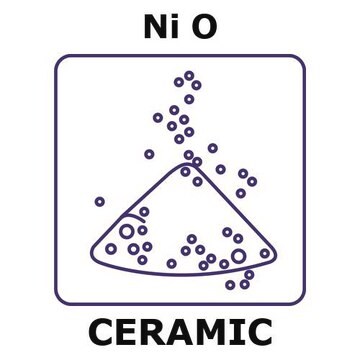203882
Nickel(II) oxide
99.99% trace metals basis
Sinónimos:
Nickel monoxide, Nickelous oxide
About This Item
Productos recomendados
Quality Level
assay
99.99% trace metals basis
form
powder and chunks
composition
NiO
greener alternative product characteristics
Design for Energy Efficiency
Learn more about the Principles of Green Chemistry.
sustainability
Greener Alternative Product
color
green
density
6.67 g/mL at 25 °C (lit.)
application(s)
battery manufacturing
greener alternative category
SMILES string
[Ni]=O
InChI
1S/Ni.O
InChI key
GNRSAWUEBMWBQH-UHFFFAOYSA-N
¿Está buscando productos similares? Visita Guía de comparación de productos
Categorías relacionadas
General description
Application
- non-enzymatic glucose sensor
- hydrogen production
- dye-sensitized solar cells (DSSCs)
signalword
Danger
hcodes
Hazard Classifications
Aquatic Chronic 4 - Carc. 1A Inhalation - Skin Sens. 1 - STOT RE 1 Inhalation
target_organs
Lungs
Storage Class
6.1C - Combustible acute toxic Cat.3 / toxic compounds or compounds which causing chronic effects
wgk_germany
WGK 1
flash_point_f
Not applicable
flash_point_c
Not applicable
ppe
Eyeshields, Faceshields, Gloves, type P3 (EN 143) respirator cartridges
Elija entre una de las versiones más recientes:
¿Ya tiene este producto?
Encuentre la documentación para los productos que ha comprado recientemente en la Biblioteca de documentos.
Los clientes también vieron
Artículos
An article concerning self-propagating reactions induced by mechanical alloying, presented by Sigma-Aldrich.com.
The prevailing strategies for heat and electric-power production that rely on fossil and fission fuels are having a negative impact on the environment and on our living conditions.
Professor Chen (Nankai University, China) and his team explain the strategies behind their recent record-breaking organic solar cells, reaching a power conversion efficiency of 17.3%.
Global Trade Item Number
| Número de referencia del producto (SKU) | GTIN |
|---|---|
| 740136-1G | 4061826645055 |
| 203882-20G | 4061838766465 |
| 203882-100G | 4061838766458 |
Nuestro equipo de científicos tiene experiencia en todas las áreas de investigación: Ciencias de la vida, Ciencia de los materiales, Síntesis química, Cromatografía, Analítica y muchas otras.
Póngase en contacto con el Servicio técnico








